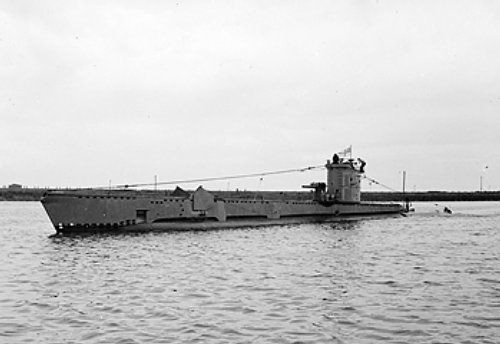The U-864 was a German Type IXD2 U-boat from World War II, known for its fateful mission under Operation Caesar to transport vital materials to Japan.

On its voyage in February 1945, the submarine was detected and trailed by the British submarine HMS Venturer off the coast of Fedje, Norway.
In a historic naval confrontation, U-864 became the first submarine to be intentionally sunk by another while both were submerged.
Background Of U-864
The U-864 was a Type IX U-boat launched in 1943. As one of the larger classes of German submarines, it was designed for long-range operations and was equipped with a more considerable fuel capacity than other U-boats.
The IX variant was more extended and had a longer range than its counterparts, making it suitable for missions that required covering vast distances.
 A Type IX U-Boat similar to U-864.
A Type IX U-Boat similar to U-864.
The Critical Mission
As the war progressed and the Allies gained momentum, Germany became increasingly desperate to turn the tide in their favor. This desperation led to what was known as Operation Caesar.
The mission of U-864 under Operation Caesar was critical to Germany’s war efforts. The submarine was tasked with transporting a cargo of strategic importance to Japan, one of Germany’s allies.
This cargo was said to include 65 tons of mercury contained in 1,857 steel flasks, crucial for the production of weapons and ammunition.
The Journey
U-864 left Bergen, Norway, on February 6, 1945, under the command of Ralf-Reimar Wolfram. However, unbeknownst to the German command, the Allies had cracked the Enigma code and were privy to much of Germany’s naval communications.
British intelligence had caught wind of U-864’s mission and dispatched the submarine HMS Venturer, commanded by Lieutenant Jimmy Launders, to intercept and neutralize the threat.
As U-864 proceeded with its mission, it faced several mechanical issues, primarily with its engines. These problems forced the vessel to surface, making it vulnerable to detection. By a twist of fate, the submarine was detected by HMS Venturer.
The Historic Confrontation
On February 9, 1945, off the coast of Fedje, Norway, HMS Venturer identified U-864. The German U-boat was unaware of the British submarine’s presence, as the Venturer was operating without using active sonar, making it virtually silent and undetectable.
 HMS Venturer pictured in 1943.
HMS Venturer pictured in 1943.
For several hours, Venturer trailed U-864, waiting for the opportune moment to strike. What followed was a tense game of cat and mouse beneath the waves, with Launders anticipating the moves of his adversary.
Then, in an unprecedented move in naval warfare history, Launders decided to attack the U-864 using a calculated spread of torpedoes without the aid of sonar.
After the fourth torpedo was fired, one hit the U-864, causing a massive explosion.
The German submarine was destroyed, sinking to the bottom of the sea, taking with it its precious cargo and the entire crew.
This event marked the first and only time in naval history that one submarine had intentionally sunk another while both were submerged.
The tactics displayed by Launders showcased not only his strategic acumen but also the advancements in naval warfare techniques during WWII.
How deep is the U-864?
When the U-864 sank in the North Sea, it reached the sea floor at 490 ft deep. It sank while it was trying to avoid torpedoes from the HMS Venturer.
The U-864 used zigzagging maneuvers, which made it a difficult target to attack. In the end, the fourth torpedo damaged it. Then, the submarine exploded, cracked in two, and sank.
Legacy Of U-864
The sinking of U-864 was a considerable blow to the Axis powers, as the crucial materials and technology meant for Japan never reached their destination. This event undoubtedly played a role, however minor, in the overall outcome of the war.
Decades later, in the early 2000s, the wreckage of U-864 was discovered off the coast of Norway.
The presence of mercury in the wreckage posed an environmental risk, leading to discussions about how best to deal with the sunken submarine.
After evaluations, it was decided to encase the submarine in sand and gravel to prevent mercury leakage.





